I was going to do a post on annual flowers for your gardens, but there are so many beautiful perennials blooming now that I think I'll share with you what's in bloom now.
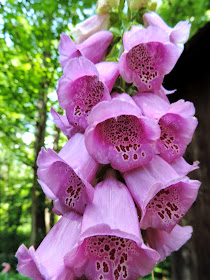 |
| Foxglove |
The foxgloves are finishing up, but some buds are still hanging on. If you have a new foxglove that you planted this year and it flowered and died, DON'T throw it out or cut it back. It's forming seeds for next year's plants. This plant usually only lives two years, it's considered a biennial. The first year it comes up from a seed and forms a small plant, but does not flower. The second year it comes up, flowers, produces seeds and dies. So if you haven't destroyed your foxgloves before they went to seed you should have plenty coming up in your garden next year.
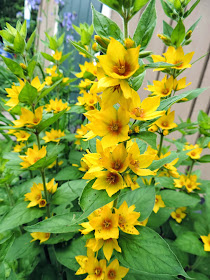 |
| Yellow Loosestrife |
Yellow Loosestrife (Lysimachia vulgaris). There are different forms of loosestrife, and the yellow form is not invasive (at least in our area of Central/Northern New York). However, different plants may be more aggressive depending on the soil conditions and the location where you planted them. Some forms of invasive loosestrife are the purple loosestrife and the gooseneck loosestrife. The purple loosestrife has been known to take over wetland areas where native wetland birds nest and forage for food. The yellow form, as pictured at left, is aggressive, but it's easy to control. Depending on which state you live in it can be considered an invasive species. When your plant is spreading out farther than where you want it to go, you can just dig up some and either plant it in another area or share it with friends. It blooms from June through August, but mine just started blooming (early July). My friend (Charlotte F.) shared this with me.
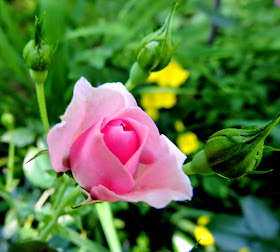 |
| Cluster Roses are blooming |
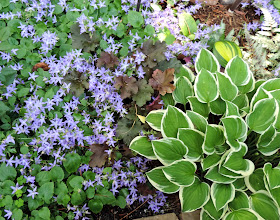 |
| Low growing campanula (possibly Blue Waterfall) |
I planted the low-growing campanula (pictured at right) with some small hostas and heuchera (coral bells) at the edge of our small patio. I wanted to keep the plants around it short so you don't feel like you are in a small enclosed space. I think campanula might be of the variety Blue Waterfall. I tried this campanula in a sunny area and it didn't do as well. When I moved it to this area, which is partially shaded, it took off. After it blooms you can cut back the flowers and it may re-bloom for you. It makes a nice ground cover that is not invasive.
 |
| Campanula glomeata |
This is another variety of campanula bell flower called Clustered Bellflower or Campanula glomerta. It will grow from 8" to 23". It is native to Europe and it is naturalized in the US. It will grow in just about all soil types except wet areas. It can be a very aggressive plant, and the flowers are beautiful. Just be careful where you plant it or otherwise you'll be digging up seedlings every year to keep them from taking over. Another plant shared from my friend Charlotte.
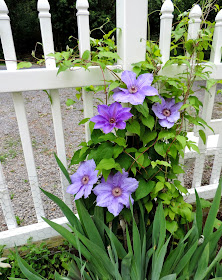 Clematis.
Clematis. Quite a few of the clematises are in bloom now. I took these photos are from a friend's garden (Sue O.). They look beautiful on her white fence.
 |
| Yarrow - a hot pink variety |
Yarrow. The yarrow is blooming now. Yarrow is actually a herb. It's very easy to care for. Plant them in full sun. (In some places they might be aggressive, but they haven't been too bad where I planted them.) They do best in well drained soil. And the DO NOT need to be fertilized. Just water them when it is very dry.
 |
| Yarrow - this one might be called Paprika (a red variety) |
 |
| Blooms of Mock Orange shrub (not my shrub) |
I have a mock orange that I planted several years ago, and I'm about ready to dig it out. It has never bloomed for me. It probably doesn't get enough sun where it's planted. Maybe before I throw it out I'll cut it back and transplant it somewhere.
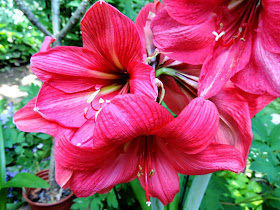 |
| Amaryllis |
I purchased the amaryllis (pictured above) when I was in Florida this past year. It was a very large bulb. I planted it when we got home and it just finished blooming. Now that it's done flowering, I'll cut back the flower stalks when they start to droop (this bulb produced two stalks), and leave the green leaves on the plant. Then just continue to water it throughout the summer. I leave it in the pot it's planted in. The leaves will turn yellow and dry up in the fall. Then cut the dried leaves to about 2 inches. At this time of year I'll stop watering the plant. You can dig up the bulb, but I have left it in the same pot with good results. I'll put it in my basement during the dormant period and in spring I will bring out the bulb in the pot and start watering it again. This bulb is not cold hardy and will not survive our cold winters. They will only survive in Hardiness Zones 9-11.
 |
| Giant Hogweed |
Noxious Plant - Giant Hogweed. The following information was published in (Syracuse) The Post-Standard/Stars on Sunday, May 11, 2014 by Carol Bradford, Columnist.
The New York State Department of Environmental Conservation has set up a giant Hogweed Hotline at 845-256-3111 for the 2014 season.
Giant Hogweed is a non-native, invasive Federal Noxious weed that grows abundantly in some areas of Central New York, especially to the northwest of Syracuse. View a map of known locations at http://www.dec.ny.gov/animals/41952.htmlGiant Hogweed is the largest herbaceous plant found in New York. It can grow 14 feet tall, with leaves 5 feet across, and flowerheads 2 & 1/2 feet across. Contact with sap can cause severe burns, permanent scarring and even blindness if it gets into eyes.
Funding has been made available by New York State and by the United States Forest Service for monitoring and controlling the weed. If you want to know how to identify it and what to do if you spot it, consult Giant Hogweed - NYS Dept of Environmental Conservation. The hotline is also a place to ask questions, report sightings and get help identifying the plant.
DO NOT TOUCH A PLANT IF YOU SUSPECT IT MIGHT BE GIANT HOGWEED. It's especially dangerous to people who are doing fieldwork or trimming roadside vegetation. Giant Hogweed spreads by seed and via people. Don't plant it on purpose.
Here is a video report from Michigan on the Giant Hogweed.
Giant Hogweed YouTube Video reported from Michigan
* * * * * * *
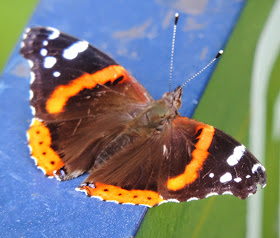 |
| Red Admiral butterfly |
 |
| Red Admiral butterfly |
"Help us to be ever faithful gardeners of the spirit, who know that without darkness nothing comes to birth, and without light nothing flowers."
~May Sarton
Thanks for stopping by,
feel free to leave a comment.
I would love to hear from you.














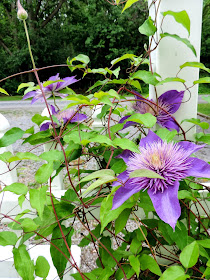
Love your summer flowers.I do miss alot of the plants that grow 'up North.' It's just too dang hot,here,to do much more than weeding and some pruning.
ReplyDeleteThanks Chris. Sometimes it's just too hot to weed here, too (or at least it's a good excuse for me to get out of it). But usually our nights cool off and the mornings are nice too for the garden chores.
DeleteOh Sue the red admirals are visiting you too...gorgeous blooms too....I love foxglove...mine were scarce this year.
ReplyDeleteThanks Donna. Yes, I saw this one a few weeks ago and I was lucky he landed at all. He was flying around so fast I didn't think he was going to come down. My foxgloves were scarce this year, too, but I should have a lot for next year because there are tons of seedlings. Let me know if you want some seedlings and I'll pot some up for you.
ReplyDeleteVery pretty photos of your garden flowers. I always leave my foxgloves in the garden to go to seed too. I have had them for many years. Giant Hogweed is in our area too. As a MG, we keep track of them and report locations.
ReplyDeleteThank you Donna. I've had foxgloves for several years now, too. A few years ago they came up real spindly looking so I was pulling them up thinking they had a disease. But after I thought about it I think maybe it was because they did not get enough sun. When they dry up and go to seed I like to scatter the seeds around in other areas of my yard to help fill in.
DeleteThat Giant Hogweed is scary stuff.
Thanks for visiting my blog the other day. Your garden looks lovely, and you have helped me identify a plant I've seen around our area in great profusion lately--the Yellow Loosestrife. My foxgloves all bloomed in the fall last year. I have dozens upon dozens of seedlings now. Had not heard of Giant Hogweed. What a monster!
ReplyDeleteThank you Kimberley. I enjoyed reading your blog. And glad to have helped you. Sometimes flowers look similar and people know them or refer to them as different names. When the Yellow Loosestrife was given to me I didn't know the name of it either. Purple loosestrife is very prevalent in our area. And I have seen a few patches of Giant Hogweed in our area as well. That stuff is bad news. Thanks for your comments.
DeleteBeautiful blooms! I especially love the clematis and the foxglove. And the Red Admiral, one of my favorite garden visitors.
ReplyDeleteThank you, Dorothy. The clematis flower is one of my favorites. And I've had very good luck with foxgloves, too. I was lucky that the Red Admiral rested for about a minute so I could snap his picture. Thanks for commenting.
DeleteHello again Susan : )
ReplyDeleteThis is a very nice post with such pretty flowers and great information. We in Ontario are also on the alert about hogweed ... so many plants now that we have to take seriously that they do have a damaging affect on the environment.
My yarrow is doing nothing this year .. Strawberry Seduction was my favorite for a new yarrow but it is just sitting there staring at me flower-less this year!
But .. Cheyenne Spirit coneflower is a wow factor !
That I can safely recommend ! haha
Joy
Hi Joy, Thank you! I don't think you are too far from us if you are in Kingston, Ontario. (I saw your weather info on your blog post). We are north of Syracuse.
DeleteLuckily, my yarrow doesn't do too much, and I'm glad that it's not aggressive. I've read that it can be aggressive in some areas. I purchased a new coneflower this year, too. (but I forgot the name and I lost the tag). It's a fire-red color and it looks like a zinnia. I'm hoping it gets a little taller next year. Your Cheyenne Spirit sounds great! Thanks again for stopping by!